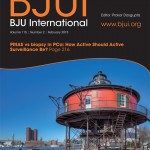Article of the Week: HLE and PVP for Patients with BPH and CUR
Every week the Editor-in-Chief selects the Article of the Week from the current issue of BJUI. The abstract is reproduced below and you can click on the button to read the full article, which is freely available to all readers for at least 30 days from the time of this post.
In addition to the article itself, there is an accompanying editorial written by a prominent member of the urological community. This blog is intended to provoke comment and discussion and we invite you to use the comment tools at the bottom of each post to join the conversation.
Finally, the third post under the Article of the Week heading on the homepage will consist of additional material or media. This week we feature a video from Dr. Axel Merseburger discussing his paper.
If you only have time to read one article this week, it should be this one.
Holmium Laser Enucleation and Photoselective Vaporization of the Prostate for Patients with Benign Prostatic Hyperplasia and Chronic Urinary Retention
Christopher D. Jaeger, Christopher R. Mitchell, Lance A. Mynderse and Amy E. Krambeck
Department of Urology, Mayo Clinic School of Medicine, Rochester, MN, USA
OBJECTIVES
To evaluate short-term outcomes of holmium laser enucleation of the prostate (HoLEP) and photoselective vaporisation of the prostate (PVP) in patients with benign prostatic hyperplasia (BPH) and chronic urinary retention (CUR).
PATIENTS AND METHODS
A retrospective chart review was performed of all patients with CUR who underwent HoLEP or PVP at our institution over a 3-year period. CUR was defined as a persistent post-void residual urine volume (PVR) of >300 mL or refractory urinary retention requiring catheterisation.
RESULTS
We identified 72 patients with CUR who underwent HoLEP and 31 who underwent PVP. Preoperative parameters including median catheterisation duration (3 vs 5 months, P = 0.71), American Urological Association Symptom Index score (AUASI; 18 vs 21, P = 0.24), and PVR (555 vs 473 mL, P = 0.096) were similar between the HoLEP and PVP groups. The HoLEP group had a larger prostate volume (88.5 vs 49 mL, P < 0.001) and higher PSA concentration (4.5 vs 2.4 ng/mL, P = 0.001). At median 6-month follow-up, 71 (99%) HoLEP patients and 23 (74%) PVP patients were catheter-free (P < 0.001). Of the voiding patients, postoperative AUASI (3 vs 4, P = 0.06), maximum urinary flow rate (23 vs 18 mL/s, P = 0.28) and PVR (56.5 vs 54 mL, P = 1.0) were improved in both groups.
CONCLUSIONS
Both HoLEP and PVP are effective at improving urinary parameters in men with CUR. Despite larger prostate volumes, HoLEP had a 99% successful deobstruction rate, thus rendering patients catheter-free.



